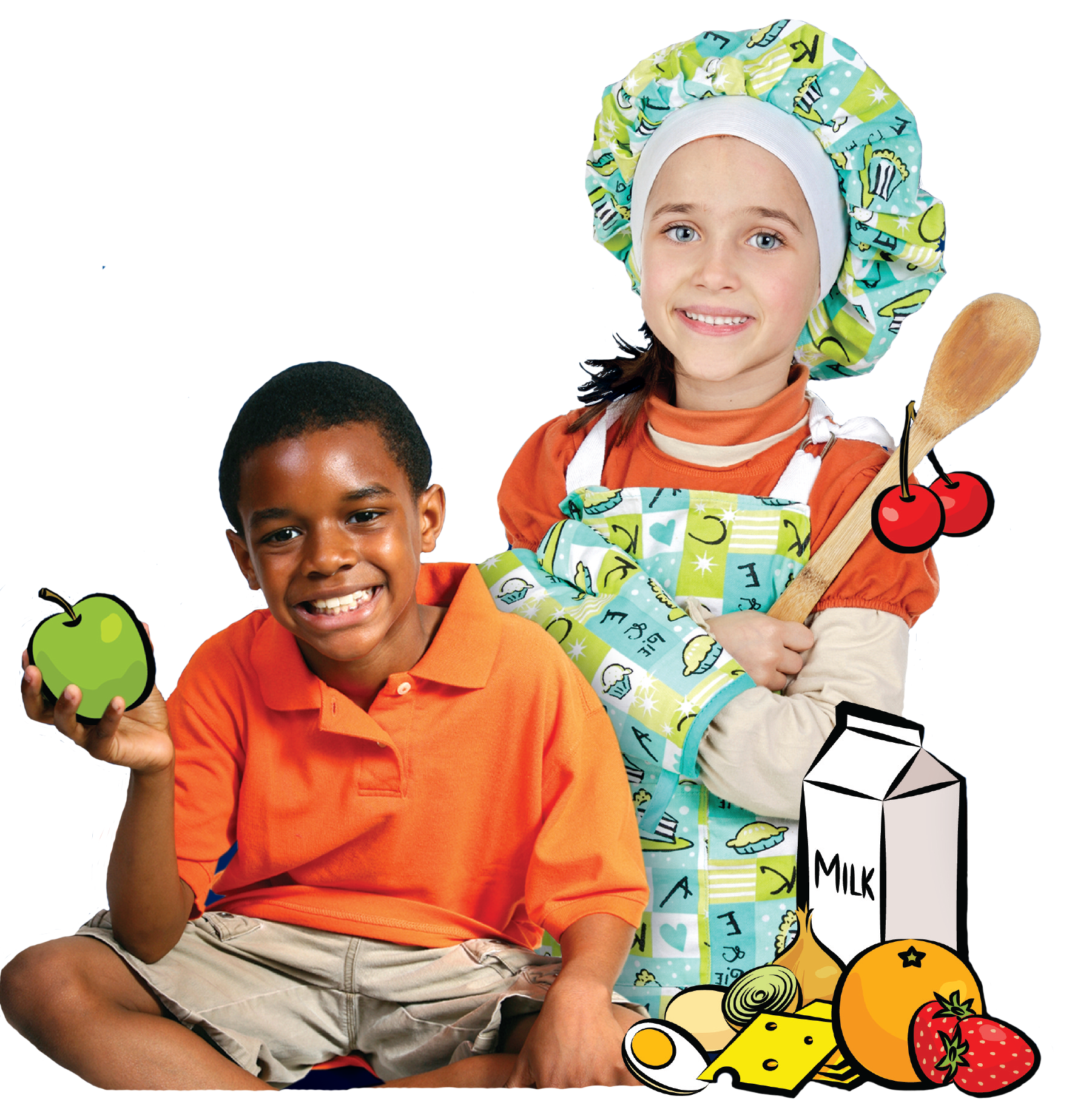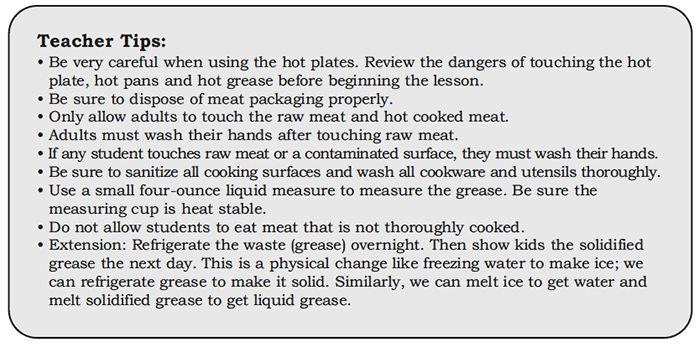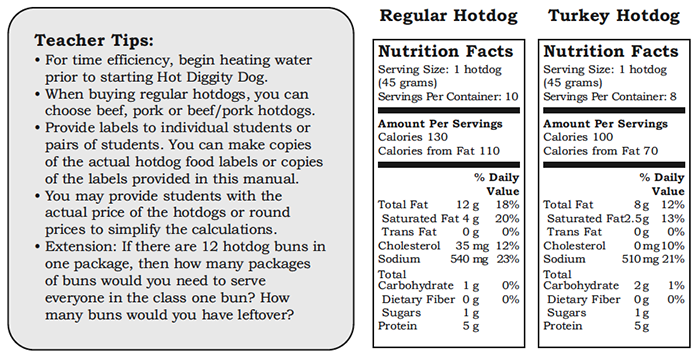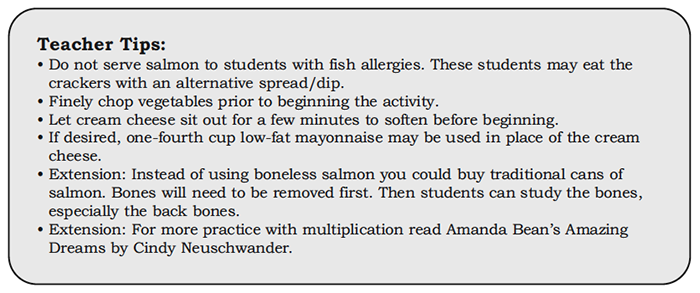 Relevancy and Engagement
agclassroom.org/or/
Relevancy and Engagement
agclassroom.org/or/
Lesson Plan
FoodMASTER: Meat, Poultry, and Fish
Grade Level
Purpose
Students discover how animals utilize nutrients and energy from food humans cannot digest and convert it to meat, a food rich in zinc, iron, and protein. Students examine how hamburger is formulated for leanness, compare two kinds of hotdogs, and investigate about fish. Grades 3-5
Estimated Time
Materials Needed
Activity 1: Lean and Fat
- For the teacher: Food scale, 4 paper plates, double burner hot plate, 2 frying pans, 1-2 spatulas, 2 liquid measuring cups, thermometer, 1 pound 70% lean ground beef (thawed), 1 pound 90% lean ground beef (thawed).
- For each student: 1 plate.
- Hamburger Hints student handout
- Lean and Fat student handout
- Teacher Answer Key
Activity 2: Healthier Hot Dog
- For the teacher: 2 large pots, double burner hot plate, tongs, 1 plate, 1 table knife, cost for each package of hot dogs, water, 1 package regular hot dogs,1 package turkey dogs.
- For each student: 1 plate, food labels for each kind of hotdog. Optional: 1/2 bun, ketchup, mustard.
- Hot Diggity Dog student handout
- Healthier Hog Dogs student handout
- Teacher Answer Key
Activity 3: Something is Fishy
- For the teacher: Mixing bowl, 1 set dry measuring cups, spoon, fork, 1-2 table knives.
- Doubled recipe: 2 salmon pouches (6-7 ounces each), 8-ounce package light cream cheese, 8-ounce jar chunky salsa, 1 1/2 cups finely chopped vegetables (celery, zucchini, cucumbers or carrots).
- Tripled recipe: 3 salmon pouches (6-7 ounces each), 2 8-ounce packages light cream cheese, 8-ounce jar chunky salsa, 2 1/4 cups finely chopped vegetables (celery, zucchini, cucumbers or carrots).
- For each student: 1 plate, 2 whole-grain crackers.
- Something is Fishy Student Handout
- Teacher Answer Key
Elaborate
Essential Files
Vocabulary
casing: outer covering of a hotdog
exoskeleton: hard covering on the outside of a living thing that supports and protects it
finfish: fish with bony skeletons; examples include catfish, flounder, and salmon
lean: containing little or no fat
omega-3 fatty acids: heart-healthy fats found in fish
shellfish: fish with soft bodies inside a shell or exoskeleton. Examples: Clams and crabs
waste: part of the meat that is not used/eaten, such as grease
Background Agricultural Connections
Introduction to FoodMASTER:
FoodMASTER (Food, Mathematics and Science Teaching Enhancement Resource) is a compilation of programs aimed at using food as a tool to teach mathematics and science. It is our theory that if food is used as a tool to teach mathematics and science, students will be better prepared to demonstrate and apply mathematic and scientific knowledge. Because students encounter food on a daily basis, they have preexisting contextual experiences preparing them for learning new and relevant mathematics and science material.
Food is conducive to hands-on and virtual, inquiry-based, active learning that uses multiple senses to engage students in the learning process. Utilizing food allows for an interdisciplinary approach to learning concepts and ideas in a variety of scientific subjects like general science, biology, chemistry, microbiology, nutrition and health. Additionally, food labs are a dynamic way to teach mathematics concepts such as numbers and operations, algebra, geometry, measurement and problem solving.
The knowledge and skill development that can be inspired by the FoodMASTER approach is limitless. Proper use of measurement tools, data collection and interpretation, application and generalization, classification and organization, graphing and comparative analysis, understanding chemical changes, observing functions of ingredients and controlling variables, pricing, critical thinking, self-directing learning, and team building are only a few of the potential knowledge and skill development areas for intermediate grade students experiencing FoodMASTER’s scientific inquiry labs.
Additional FoodMASTER lessons can be found to cover health and nutrition topics such as:
- Food Safety
- Vegetables
- Fruits
- Meat, Poultry, and Fish
- Eggs
- Fats and Oils
- Grains
- Measurement
- Meal Management
Background for this Lesson:
Meat, poultry, fish, eggs and beans are all part of the protein foods group. Meat comes from animals, such as cows (beef), pigs (pork), lambs, rabbits, deer (venison) and goats. Chickens, turkeys, ducks, geese and other birds we eat are all called poultry. Catfish, flounder, salmon, crabs and shrimp are all fish. Meat, poultry and fish are full of protein along with other vitamins and minerals.
In this lesson, students will:
- identify the healthier ground beef and compare different percentages;
- select appropriate measurement tools for measuring weight and volume;
- practice measurement skills using appropriate units for weight and volume and real-life mathematics to practice subtraction and division;
- find serving size, calories, total fat, saturated fat and sodium on food label Nutrition Facts panels;
- correctly evaluate hotdogs based on nutritional value and taste;
- apply division and multiplication skills to solve problems;
- identify examples of finfish and shellfish;
- accurately measure ingredients and communicate the importance of using mathematics to solve real life problems;
- double and triple a recipe, complete a chart, and pull information from a table to answer questions; and
- understand that fish are healthy because of omega-3 fatty acids.
Engage
- Brainstorm with your students and make a list on the board of all the different types of meat familiar to them.
- Ask students if they know where these meats originate. The majority of the meat in our food supply is produced by animals that are raised on farms and ranches. Meat, provided by animals, is an important and abundant source of protein in human diets.
- Animals can utilize nutrients and energy from food that humans cannot digest. To illustrate this to your students show them this picture of a pasture and rangeland. Ask your students, "If this is where you lived and you couldn't go anywhere else, could you survive eating only the grass and other plants in this picture?" Ask them, "Do you see anything that would taste good?" The correct answer is, no. Humans cannot digest and utilize the energy and nutrients found in pastures and on rangelands. However, many livestock animals that are raised for their meat, can! Cattle, sheep, and goats all have a stomach with 4 chambers. They can digest and gain nutrients and energy from feed that humans cannot. The result is that livestock animals convert and utilize energy to produce food (meat and milk) that humans can gain benefit from. In this lesson, students will be learning about the nutritional benefits of meat in our diets.
Explore and Explain
Activity 1: Lean and Fat
- Read Hamburger Hints and complete the Doodle Bugs.
- Begin the scientific inquiry by weighing the beef. First, place a paper plate on the scale and zero the scale. Add 70% lean ground beef and weigh. Repeat with 90% lean ground beef. Be sure to explain to students why you zeroed the scale — to make the weight of the plate disappear.
- Place the 70% and 90% lean ground beefs in separate frying pans. Heat on the double burners over medium-high heat.
- While the meat is browning, ask your students the following questions: “How is the appearance of the meat changing? What is the percent fat of the 70% lean ground beef? What is the percent fat of the 90% lean ground beef? Which type of ground beef has more fat? Would it be healthier to eat 70% lean ground beef or 90% lean ground beef? If the meat didn’t have any fat, what percent fat would it be and what percent lean would it be?” Remind students that the percent fat and percent lean always add up to 100%.
- Cook the meat thoroughly to 160 degrees Fahrenheit. Then drain the grease into small measuring cups.
- Let the grease cool. Then ask students to read the volume of the grease.
- Measure the after cooking weight of each type of ground beef. Remember to zero the scale with a new plate on top before adding the ground beef.
- Instruct students to complete the Ground Beef Facts table on the Lean and Fat handout and answer the questions.
- Students may taste the two ground beefs. Ask students which they like best.
- Work as a class to calculate the before and after cooking cost per ounce of each type of ground beef.

Activity 2: Healthier Hot Dog
- Place two pots on a double burner. Fill each pot three-fourths full with water and begin heating over medium heat.
- Read Hot Diggity Dog and complete the Doodle Bugs.
- When the water boils, carefully add four to eight regular hotdogs to the first pot and four to eight turkey hotdogs to the second pot.
- Boil hotdogs for three to five minutes (or as directed per package instructions).
- While the hotdogs are boiling, your students may complete the Hotdog Facts table. Remind students where to find serving size, calories, total fat, saturated fat and sodium on food labels.
- When the hotdogs are done, use tongs to remove them from the pot and place them on a plate.
- Use a table knife to slice the hotdogs into chunks. Place a sample of each type of hotdog on each student’s plate. Optional: Squirt ketchup and/or mustard for dipping on each student’s plate. If desired, place whole hotdogs in a bun and then cut into smaller portions for each student to try.
- Discuss the nutrition and taste of each hotdog. Instruct students to complete the Cost of One Hotdog table and remaining questions.

Activity 3: Something is Fishy
- Read Something is Fishy and complete the Doodle Bugs.
- Explain doubling and tripling a recipe. Complete the first row of the Double and Triple Recipes table as a class.
- Students will complete the rest of the table as a class, in small groups or individually. Use the chart to help students explore the relationship between addition and multiplication.
- Classes with about 24 students should use the doubled recipe. Larger classes may choose to use the tripled recipe.
- Follow the Scientific Inquiry: Fish in the Kitchen directions to prepare the salmon spread. Allow students to help measure and stir ingredients.
- Instruct students to complete the While You Wait: Oh My! Omega page, while waiting to be served the salmon spread.
- Students will taste the salmon and answer the remaining questions.
- Refrigerate any leftovers.

While you Wait: O My! Omega
- Students will read the short paragraph from O My! Omega student activity sheet.
- Direct students to read the chart and use the chart to answer the three questions.
- Discuss the heart health benefits of eating fish. Remind students that fried fish is less healthy.

Elaborate
-
Expand your knowledge about pork as a source of protein. Use the Pork: Sustainable and Healthy Protein educator packet for activities relating to environmental sustainability and the influence of traditions and culture on the food we eat. You can also explore pork recipes, learn about cuts of pork, and dig deeper into pork nutrition.
-
Hungry Hens: Complete this math enrichment activity. Students will learn more about balancing a hen's diet to allow her to have the calcium and nutrients she needs to produce eggs.
Evaluate
After conducting these activities, review and summarize the following key concepts:
- Meat is typically provided by livestock animals such as cattle, sheep, pigs, chickens and turkeys as well as fish. These animals are raised on farms and ranches.
- Livestock animals can utilize nutrients from food that humans cannot (such as grass). Animals convert this energy into meat that humans can gain vital nutrients from.
- Meat provides zinc, iron, and protein to our diets.
Acknowledgements
- Created by: FoodMASTER- Food, Math, and Science Teaching Enhancement Resource
- Sponsored by: SEPA- Science Education Partnership Award
- Partnered with: Ohio University and East Carolina University
- Graphics provided by FoodMASTER
Recommended Companion Resources
- A Pocketful of Goobers
- Are consumers ready to embrace and eat lab-grown meat?
- Cattle Kids: A Year On the Western Trail
- Eat Happy Project Video Series
- Food Group Puzzle
- From Peanut to Peanut Butter
- How Do You Grow a Fish Sandwich? Video
- In the Garden with Dr. Carver
- Look Inside Food
- Meat Cut Fact Cards
- Nutrition Posters
- Pigs
- Sheep on the Farm
- The Science of Cooking
- Who Makes the Best Burger?